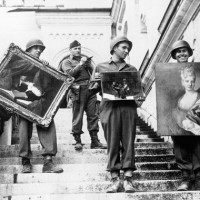-
Continuing the Hunt To Recover Nazi Looted Art
03/21/2013
 As Nazi forces bombed and invaded Europe during World War II, they also stole an estimated five million works of art and cultural objects from museums, universities, and private collectors alike. As a recent New York Times article points out, great efforts have been made—and continue to be made—to recover those stolen works, some of which have popped up where some would least expect to find them.
As Nazi forces bombed and invaded Europe during World War II, they also stole an estimated five million works of art and cultural objects from museums, universities, and private collectors alike. As a recent New York Times article points out, great efforts have been made—and continue to be made—to recover those stolen works, some of which have popped up where some would least expect to find them.
Just the other week, for example, German Chancellor Angela Merkel received some unsettling and embarrassing news from journalists for German newspaper Der Spiegel, who—ironically—were working on an article about Nazi-looted artworks still located in government buildings. They informed Chancellor Merkel that her Persian office rug was part of Hermann Goering’s vast collection. The rug was immediately removed from her office.
It is unclear how the rug made it its way into Merkel’s office, but it is not an isolated case. A tapestry, also from Goering’s collection, hangs on the wall of a government guest house near Bonn, while a walnut secretary seized by Hans Posse, the Nazi administrator for stolen art, stands in the German president’s office in Berlin. In fact, Der Spiegel has said that the rug, along with more than 600 objects from the collections of Goering and others, are still in use by the German government. In response, former state minister for culture Michael Naumann is urging the government to return Nazi-looted items to their rightful owners or their heirs.
Across the English Channel, Oxford University’s Ashmolean Museum recently received a gift of nearly 500 pieces of Renaissance silverware worth tens of millions of pounds. The significant gift did not come unencumbered, however, as much of the silver, which comes from the collection of the late Michael Wellby, was assembled in the 1940’s from German sources.
These cases highlight the imperative need for more research concerning the location of Nazi-looted art. This is easier said than done, however. For one thing, while it is believed that Germany’s 6,000 museums are filled with Nazi-looted objects, there are simply not enough staff members to research their provenances. But ignorance of problematic provenances does not mean problems do not exist, and governments and museums alike must take seriously and begin in earnest the process of reuniting these objects with their rightful owners.
Art Law Blog
